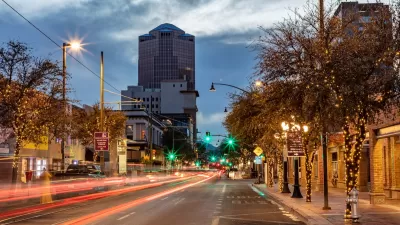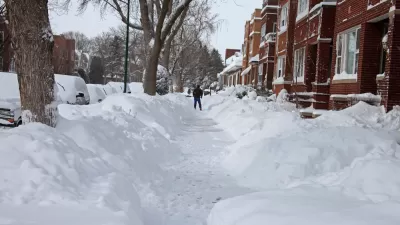In theory, sidewalks are what make cities walkable. But in Washington, D.C., many sidewalks are not accessible to the people who use them.

Barbara Moreno writes about Project Sidewalk, an online crowdsourced accessibility audit of sidewalks in Washington, D.C. Volunteers reported sidewalk obstructions on almost 1,500 miles of city sidewalks, and an interactive map shows the results. Sidewalk accessibility was most often impeded by obstructions such as trash cans, notes Moreno. A lack of curb ramps and surface problems—a broken pavement, for example—were the other most common impediments.
The most issues were located around the National Mall. The findings also show that sidewalk obstructions were not limited to less affluent neighborhoods: half of neighborhoods with the most obstructions were in high-income D.C. neighborhoods.
The Project Sidewalk findings illustrate how the presence of sidewalks does not automatically mean neighborhoods are walkable and accessible. "For parents pushing babies around in strollers, a big crack in a sidewalk can be an unwelcome nuisance. For wheelchair users and others with limited mobility, obstructions like these can make a sidewalk almost entirely inaccessible. A city is only as accessible as its sidewalks. And access to quality sidewalks is paramount for all people walking," says Moreno.
FULL STORY: A city is only as accessible as its sidewalks. This map shows DC’s are often blocked.

Maui's Vacation Rental Debate Turns Ugly
Verbal attacks, misinformation campaigns and fistfights plague a high-stakes debate to convert thousands of vacation rentals into long-term housing.

Planetizen Federal Action Tracker
A weekly monitor of how Trump’s orders and actions are impacting planners and planning in America.

Chicago’s Ghost Rails
Just beneath the surface of the modern city lie the remnants of its expansive early 20th-century streetcar system.

Bend, Oregon Zoning Reforms Prioritize Small-Scale Housing
The city altered its zoning code to allow multi-family housing and eliminated parking mandates citywide.

Amtrak Cutting Jobs, Funding to High-Speed Rail
The agency plans to cut 10 percent of its workforce and has confirmed it will not fund new high-speed rail projects.

LA Denies Basic Services to Unhoused Residents
The city has repeatedly failed to respond to requests for trash pickup at encampment sites, and eliminated a program that provided mobile showers and toilets.
Urban Design for Planners 1: Software Tools
This six-course series explores essential urban design concepts using open source software and equips planners with the tools they need to participate fully in the urban design process.
Planning for Universal Design
Learn the tools for implementing Universal Design in planning regulations.
planning NEXT
Appalachian Highlands Housing Partners
Mpact (founded as Rail~Volution)
City of Camden Redevelopment Agency
City of Astoria
City of Portland
City of Laramie





























